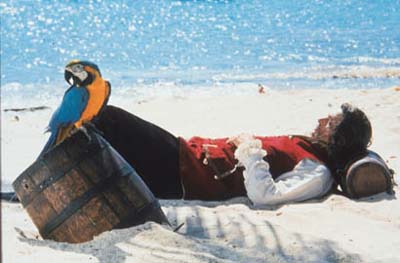 "Vexation Island", 1997 Laser disc projection, 9 minute loop Courtesy Lisson Gallery Rodney Graham From his famous upside-down photographs of trees to his award-winning film at the 1997 Venice Biennale, Canadian artist Rodney Graham is one of the most intriguing artists of his generation. The Whitechapel Art Gallery presents the largestand most complete assembly of Graham's work shown in Europe to date. Vancouver-based artist Rodney Graham has been creating photographs, installations, music, book works and film since the late 1970s. Drawing from such diverse sources as Lewis Carroll, Kurt Cobain and Ian Fleming, Graham leads the viewer through literary, film and musical references. Inspired by his interest in cyclical narratives, Sigmund Freud and the unconscious, the works in the exhibition are loosely grouped into five sections and trace a psychological journey beginning with sleep and entry into a dream-like world with the first work in the exhibition, Halcion Sleep (1994). The first section, Parallel Reality, in the Lower Gallery introduces Graham's early explorations into the relation between perception and reality. The artist's ongoing fascination with optical principles is reflected in his models of a camera obscura and several of his inverted photographs of trees. The second section, The Recurring Dream, includes Graham's celebrated film trilogy - Vexation Island (1997), How I Became a Ramblin' Man (1999) and City Self/Country Self (2001). These cinematic costume dramas show the artist as a variety of fantastical characters locked in cycles - as a marooned sailor on a Pacific island, a lonesome cowboy repeatedly setting off into the sunset and a 19th century Parisian dandy perpetually accosting his country self. The films are looped, in a device that parallels the recurrence of repressed traumatic memories. Between the Lines in the Upper Gallery then focuses on the artist's interest in literature and language, through his book works, texts and literary appropriations. In works such as Reading Machine for Lenz (1993), Graham is prompted by a repetition in a text that he exploits to reach an illogical conclusion. In Performance, the fourth section, Graham explores music practice and instruction in works such as Parsifal (1882 - 38, 969, 364, 735), (1990) and Aberdeen (2000). Graham takes Richard Wagner, his assistant Englebert Humperdinck, Sigmund Freud and Kurt Cobain as his subjects, and by infiltrating these artists' practices comments on values of authorship and originality. The final section, Bliss, plays with different states of reality through films such as Phonokinetoscope (2001) and Coruscating Cinnamon Granules (1996), photography and sculpture. If these attempts at altering perceptions of reality fall short of an idyllic experience, then returning to Halcion Sleep in the foyer shows the artist regress to childhood and sedated to sleep once again. Rodney Graham is part of an ongoing programme strand at The Whitechapel Art Gallery assessing the work of an internationally renowned artist mid-career. Previous shows have included Jeff Wall (1996), Thomas Schütte (1998) and Nan Goldin - Devil's Playground (2002). Ausstellungsdauer: 24.9. - 17.11.2002 Öffnungszeiten: Di-So 11 - 18 Uhr, Fr/Mi 11 - 20 Uhr Whitechapel Art Gallery 80-82 Whitechapel High Street GB-London E1 7QX Telefon +44 20 7522 7878 (recorded information) Fax +44 20 7377 1685 E-Mail info@whitechapel.org www.whitechapel.org |